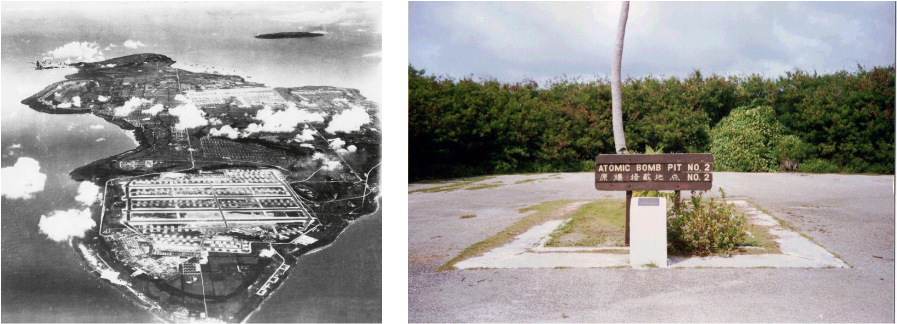The Mariana Islands [Past vs. Present]
Mariana Islands during World War 11
During World War 11 the Mariana Islands along with Guam were taken over by Allied troops with the strategic plan called “Island Hopping.” The Mariana Islands are made up of fifteen small islands, but main focus for the hop was Tinian, Saipan, and the neighboring island of Guam. (CNMI, 2006) Allies seized Saipan first, in June of 1944. Taking the largest island in the chain, Saipan, proved to be beneficial in gaining the other important islands of the chain. The islands of Gram and Tinian were taken not long after Saipan fell. The taking of the Mariana Islands was crucial in the Allied campaign. As soon as the islands were under control of the Allies, they began building airstrips for the bombers to both take off and land onto. This was essential because these islands put the Allies within striking distance of Japan’s home islands and land. Troops were stationed on the island chain until the end of 1945, when fighting ceased and Japan had officially surrendered to the Allied Nations. (US National Archives, 2003)
My Grandfather's Perspective on Tinian Island
During my interview I learned that my Grandfather, Charles Beam, was stationed on Tinian Island for his term. When he arrived to Tinian with the 306 Motor Group-Air Force, fighting had ceased on the island and he said that the natives were peaceful and they faced no Japanese resistance while entering the island. (Beam, 2011) Tinian Island was a gorgeous island; it looked like it was out of a magazine, with crystal-clear water and white sandy beaches. (Beam, 2011) My grandfather also said that Tinian was six miles wide and ten miles long. It was definitely a small but important island in the Marianas chain. “We built the runways for the bombers on crushed, white-shell coral and it was humid all the time over there.” (Beam, 2011) He also told me that it rained daily and he used a sewing machine from home to cut off their uniforms to make shorts and t-shirts, since it was so humid and hot. My grandfather told me he never saw a great deal of combat while on Tinian. The biggest threat the troops had on Tinian was the Japanese bombers raining terror down on them. “I remember on several occasions, running to the bunkers as fast as I could to take cover, because the Japanese were bombing us from above.” (Beam, 2011) He was also eager to share with me that the atomic bombs were both carried from the North Field on Tinian Island. He told me that they [allies on the island] had no idea the United States was planning on striking mainland Japan with nuclear weapons. (Beam, 2011) This just goes to show how secretive the Manhattan Project truly was. He told me the United States mainland knew before they did on Tinian. (Beam, 2011) Charles was sent home when the war ended and moved back to Shelby, North Carolina, his home town before the war.
Marianas Today
Most of the coral runways still stand today on Tinian and her fellow islands. This is a constant reminder of its vibrant past. The Mariana Islands are comprised of fifteen small islands in the South Pacific. (CNMI, 2006) The major islands that are inhabited by people include: Saipan, Tinian, and the island of Rota. (US National Archives, 2003) These islands are known as the Commonwealth of the Northern Mariana Islands. The islands have a population of just over 85,000 people total, with most of the people living on Saipan. Saipan is also the capital of the islands with over ninety percent of the population residing here. (CNMI, 2006)
The photo on the left is the infamous “North Field” on Tinian Island. This is an aerial view that was taken in 1945. The North Field is where the two B-29 bomber planes took off from carrying the atomic bombs headed for Japan. (Stewart, 2006)
The photo on the right was taken in present day. It shows the bomb pit from which the bombs were loaded into the planes. This pit held, Fat Man, the second bomb to take off from Tinian Island. (Stewart, 2006)
The photo on the right was taken in present day. It shows the bomb pit from which the bombs were loaded into the planes. This pit held, Fat Man, the second bomb to take off from Tinian Island. (Stewart, 2006)
Tinian Island was home to one of the largest Airfields in the Pacific Theater in 1945. The picture on the left showcases the white, crushed coral runways that B-29’s took off from. (CMNI, 2006)
The photo on the right shows an example of the Mariana Islands today. The Northern Mariana Islands’ main source of income is through travel and tourism, mostly from Japan. Tinian, Rota, and Saipan are heavily marketed as exotic vacation spots. The photo is from the Fiesta Resort and Spa in Saipan. (Fiesta resort and spa, 2009)
The photo on the right shows an example of the Mariana Islands today. The Northern Mariana Islands’ main source of income is through travel and tourism, mostly from Japan. Tinian, Rota, and Saipan are heavily marketed as exotic vacation spots. The photo is from the Fiesta Resort and Spa in Saipan. (Fiesta resort and spa, 2009)


